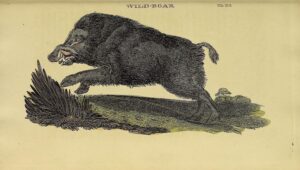Heart and mind opened by a talk from ‘Groundbreakers’ author Chantal Lyons at her local bookshop, Sue Brooks reflects on the writer’s work in the context of her own life, lived tusk by jowl with the net-slipping, rule-breaking boar of the Forest of Dean.

Image from ‘The natural history of quadrupeds, and cetaceous animals’
Bungay, [England] :Printed and published by Brightly and Co,1811 – via the Biodiversity Heritage Library
I came to live in the Forest of Dean at the height of the Foot and Mouth disease in 2001. It was a wondrously quiet place where people walked their dogs on leads and visitors drove slowly through the villages. Eight hundred sheep were culled and burned that year, including the entire population of free roaming sheep owned by local people under Commoner’s Rights dating back to the twelfth century.
Gradually sheep were reintroduced and once more amble across the roads and verges, although only a fraction of their previous numbers. The respect shown — drivers and walkers alike — towards this ancient right to roam, has not changed.
Headline news erupted into this tucked away corner of South Gloucestershire in 2004 when wild boar appeared. No one knows exactly how it happened — by escape, or intentional release from small farms, but the numbers grew rapidly. Every day there was some new outrage in the local papers about where the boar had been during the previous night. School playing fields, playgrounds, churchyards, camp sites, gardens, and the astronomical cost of fencing. DEFRA delegated the responsibility for managing wild boar, classified under the Dangerous Wild Animal Act 1976, to Forestry England. The decision, reflecting the balance of local opinion, remains to this day to restrict the numbers to approximately 400 by systematic culling.
Fired up after reading George Monbiot’s Feral (2013), and the buzz about rewilding, and needing a short piece of work for her UCL course in Science Communication, Chantal Lyons visited the Forest of Dean for research in 2014. Something happened, something life-changing. Her face was grey, as if she’d plunged it into a long-cold fire. Below ridges so like human eyebrows, her eyes met mine. It was love at first sight.
Eight years later in 2021, Chantal is back. She rents a room in the Forest. Hours, days, weeks go by without any sighting. She is honing her senses, learning to feel safe when she goes out at night. After a tip-off, she sees a Sounder. A family group of females and their babies (boarlets), led by a matriarch. It has been easy to see photos of these “humbugs” on local websites, but less so in recent years. There has been so much killing, the boar have become wary of humans and retreated into more inaccessible parts of the Forest.
Estimates of numbers continue to fluctuate (as high as 1685 in 2018). Meat is available in local butchers, shops and restaurants, and publicity has grown. Wild boar have become a visitor attraction. Chantal’s book is a marvellous antidote to all this. Her research is impeccable. She doesn’t just want a photograph; she wants to get to know how the wild boar, extinct in the UK for seven hundred years, and the humans who extirpated them, are learning to co-exist.
She talks to local people about their fears. The sense, especially for dog owners and horseriders, that I cannot go where I used to go. She enters sympathetically into the controversy close to my own heart, about the thinning of biodiversity, especially bluebells in some parts of the Forest repeatedly ploughed over by the boar. It seems inevitable when the numbers rise above a certain level.
In the final section of Groundbreakers, titled FUTURES, Chantal ranges over the possible scenarios for wild boar to return to the UK. She visits France and Spain where boar roam freely, and the Tamworth pigs at Knepp Rewilding (Tamworth because the fencing regulations required by the 1976 Act make boar prohibitively expensive). What about the fences of the mind, she asks..? The ones that make us so suspicious of the unknown — preferring to speak of “feral pigs” rather than wild boar.
Groundbreakers is powerful and timely. These wild animals have been living alongside a large human population for the best part of twenty years. They have slipped through the net and broken all the rules. Kevin Stannard at Forestry England HQ in the Forest of Dean leaves Chantal in no doubt that the entire population of wild boar would be killed if Foot and Mouth or African Swine Fever was identified.
Suddenly, the Forest has become a much wilder place. Groundbreakers has opened my heart and mind as never before. It’s a while since I last saw a boar, but walking over ground where they were rooting last night feels a privilege. The ordinary made extraordinary through Chantal’s heartfelt connection with the boar and her tireless enquiry into the forces bearing down upon them. What it might mean to lose this small stronghold of unofficial rewilding. I know I would want them back, and I wouldn’t be alone.
*
‘Groundbreakers: The Return of Britain’s Wild Boar’ is out now and available here (£19.00). You can read Kirsteen Bell’s review here.
Chantal Lyons talks at Stanfords Covent Garden on 2nd May. More info here.